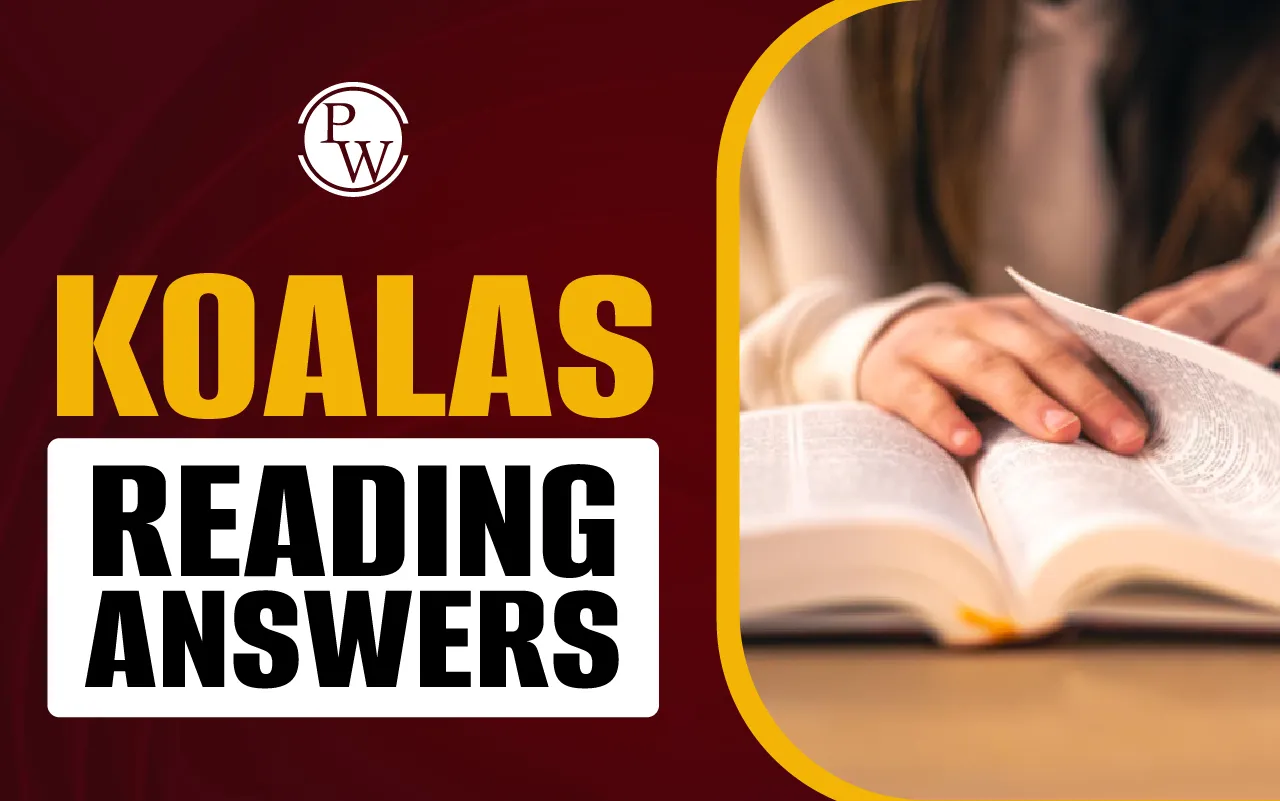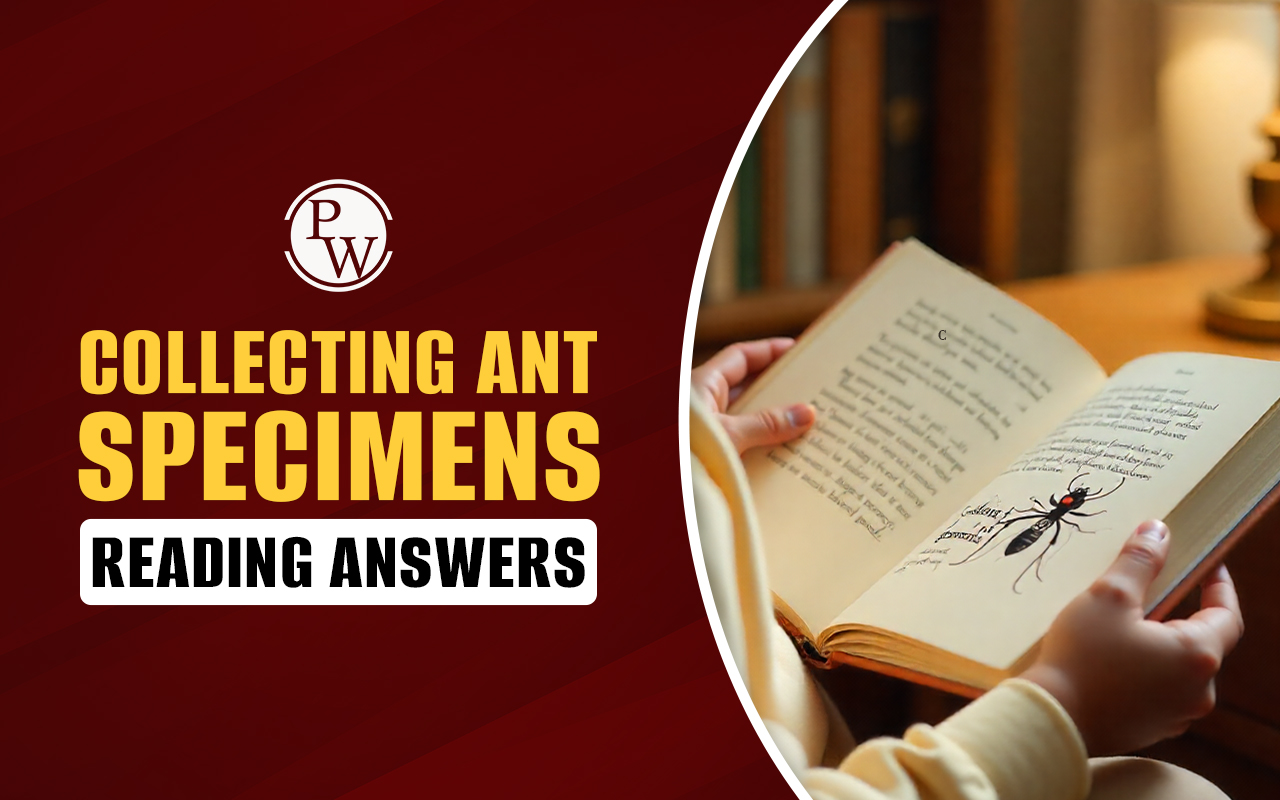

Koalas Reading Answers: One of the common topics in the IELTS Reading test is “Koalas Reading Answers.” This passage explores the fascinating life of koalas, their unique biological traits, and the challenges they face in the wild. It highlights the impact of habitat loss, diseases, and human interference on koala populations.
This guide provides a detailed passage along with answers to help IELTS 2025 aspirants improve their reading skills. The questions in this passage include True/False/Not Given, Summary Completion, and Multiple-Choice Questions. By practicing these question types, candidates can enhance their ability to locate key information and improve their overall reading comprehension. Reading through the complete guide will give a deeper understanding of the “Koalas Reading Answers” passage and help in better exam preparation.
Koalas Reading Answers Passage
Koalas
- Koalas are just too nice for their own good. And except for the occasional baby taken by birds of prey, koalas have no natural enemies. In an ideal world, the life of an arboreal couch potato would be perfectly safe and acceptable.
- Just two hundred years ago, koalas flourished across Australia. Now they seem to be in decline, but exact numbers are not available as the species would not seem to be ‘under threat’. Their problem, however, has been man, more specifically, the white man. Koala and aborigines had co-existed peacefully for centuries.
- Today koalas are found only in scattered pockets of southeast Australia, where they seem to be at risk on several fronts. The koala’s only food source, the eucalyptus tree, has declined. In the past 200 years, a third of Australia’s eucalyptus forests have disappeared. Koalas have been killed by parasites, chlamydia epidemics and a tumour-causing retro-virus. And every year 11000 are killed by cars, ironically most of them in wildlife sanctuaries, and thousands are killed by poachers. Some are also taken illegally as pets. The animals usually soon die, but they are easily replaced.
- Bush fires pose another threat. The horrific ones that raged in New South Wales recently killed between 100 and 1000 koalas. Many that were taken into sanctuaries and shelters were found to have burnt their paws on the glowing embers. But zoologists say that the species should recover. The koalas will be aided by the eucalyptus, which grows quickly and is already burgeoning forth after the fires. So the main problem to their survival is their slow reproductive rate – they produce only one baby a year over a reproductive lifespan of about nine years.
- The latest problem for the species is perhaps more insidious. With plush, grey fur, dark amber eyes and button nose, koalas are cuddliness incarnate. Australian zoos and wildlife parks have taken advantage of their uncomplaining attitudes, and charge visitors to be photographed hugging the furry bundles. But people may not realise how cruel this is, but because of the koala’s delicate disposition, constant handling can push an already precariously balanced physiology over the edge.
- Koalas only eat the foliage of certain species of eucalyptus trees, between 600 and 1250 grams a day. The tough leaves are packed with cellulose, tannins, aromatic oils and precursors of toxic cyanides. To handle this cocktail, koalas have a specialised digestive system. Cellulose- digesting bacteria in the break down fibre, while a specially adapted gut and liver process the toxins. To digest their food properly, koalas must sit still for 21 hours every day.
- Koalas are the epitome of innocence and inoffensiveness. Although they are capable of ripping open a man’s arm with their needle-sharp claws, or giving a nasty nip, they simply wouldn’t. If you upset a koala, it may blink or swallow, or hiccup. But attack? No way! Koalas are just not aggressive. They use their claws to grip the hard smooth bark of eucalyptus trees.
- They are also very sensitive, and the slightest upset can prevent them from breeding, cause them to go off their food, and succumb to gut infections. Koalas are stoic creatures and put on a brave face until they are at death’s door. One day they may appear healthy, the next they could be dead. Captive koalas have to be weighed daily to check that they are feeding properly. A sudden loss of weight is usually the only warning keepers have that their charge is ill. Only two keepers plus a vet were allowed to handle London Zoo’s koalas, as these creatures are only comfortable with people they know. A request for the koala to be taken to meet the Queen was refused because of the distress this would have caused the marsupial. Sadly, London’s Zoo no longer has a koala. Two years ago the female koala died of a cancer caused by a retrovirus. When they come into heat, female koalas become more active, and start losing weight, but after about sixteen days, heat ends and the weight piles back on. London’s koala did not. Surgery revealed hundreds of pea-sized tumours.
- Almost every zoo in Australia has koalas – the marsupial has become the Animal Ambassador of the nation, but nowhere outside Australia would handling by the public be allowed. Koala cuddling screams in the face of every rule of good care. First, some zoos allow koalas to be passed from stranger to stranger, many children who love to squeeze. Secondly, most people have no idea of how to handle the animals; they like to cling on to their handler, all in their own good time and use his or her arm as a tree. For such reasons, the Association of Fauna and Marine parks, an Australian conservation society, is campaigning to ban koala cuddling. Policy on koala handling is determined by state government authorities and the largest of the numbers in the Australian Nature Conservation Agency, with the aim of instituting national guidelines. Following a wave of publicity, some zoos and wildlife parks have stopped turning their koalas into photos.
| IELTS Exam Important Links | |
|---|---|
| IELTS Reading Band Score | IELTS Listening Band Score |
| IELTS Speaking Band Score | IELTS Writing Band Score |
Koalas Reading Answers Sample Questions
Questions 1–5
Choose the correct letter, A, B, C, or D.
Write the correct letter in boxes 1–5 on your answer sheet.
1. What is one reason why koalas have no natural enemies?
A. Their ability to climb trees.
B. Their aggressive nature.
C. Their tough skin and sharp claws.
D. Their peaceful and harmless behaviour.
2. What major threat has reduced the number of eucalyptus trees in Australia?
A. Animal grazing.
B. Industrial pollution.
C. Human activities.
D. Natural disasters.
3. Why are koalas often stressed when handled by people?
A. They are naturally aggressive.
B. They have a fragile physiological balance.
C. They dislike human scent.
D. They have sensitive hearing.
4. How do koalas process the toxins in eucalyptus leaves?
A. Through their liver and kidney.
B. Through their digestive enzymes.
C. Through specialised bacteria and their liver.
D. Through their fast metabolism.
5. Why was the koala at London Zoo not taken to meet the Queen?
A. The koala was not trained for public exposure.
B. The zoo had strict rules about animal handling.
C. The koala was unwell at that time.
D. The stress would have harmed the koala’s health.
Questions 6–12
Do the following statements agree with the information given in Reading Passage 1?
In boxes 6–12 on your answer sheet, write:
YES – if the statement agrees with the information
NO – if the statement contradicts the information
NOT GIVEN – if there is no information on this
6. Koalas were once abundant across the whole of Australia.
7. Koalas have a strong social structure and live in large groups.
8. The main reason for the decline in koala population is hunting by predators.
9. Eucalyptus trees are recovering quickly after bushfires.
10. Female koalas can give birth to more than one baby each year.
11. Koalas at London Zoo were only handled by trained staff.
12. The Australian government has already banned all public handling of koalas.
Question 13
Choose the correct letter, A, B, C, or D.
13. What is the Association of Fauna and Marine Parks’ current campaign about?
A. Increasing the koala population.
B. Banning public handling of koalas.
C. Improving koala breeding programs.
D. Protecting koalas from bushfires.
Koalas Reading Answers with Explanations
1. What is one reason why koalas have no natural enemies?
Answer: D. Their peaceful and harmless behaviour.
Location: "Koalas are just too nice for their own good. And except for the occasional baby taken by birds of prey, koalas have no natural enemies."
Explanation: The passage states that koalas are generally harmless and not aggressive, which explains why they have no natural enemies except for rare cases of predation.
2. What major threat has reduced the number of eucalyptus trees in Australia?
Answer: C. Human activities.
Location: "In the past 200 years, a third of Australia’s eucalyptus forests have disappeared."
Explanation: The passage mentions that human actions have caused significant deforestation of eucalyptus forests, which has impacted koalas' food supply.
3. Why are koalas often stressed when handled by people?
Answer: B. They have a fragile physiological balance.
Location: "Because of the koala’s delicate disposition, constant handling can push an already precariously balanced physiology over the edge."
Explanation: Koalas have a sensitive nature, and constant human contact can disrupt their physical and emotional balance, causing stress.
4. How do koalas process the toxins in eucalyptus leaves?
Answer: C. Through specialised bacteria and their liver.
Location: "To handle this cocktail, koalas have a specialised digestive system. Cellulose-digesting bacteria in the gut break down fibre, while a specially adapted gut and liver process the toxins."
Explanation: Koalas rely on bacteria in their gut and their liver to digest the toxic elements in eucalyptus leaves.
5. Why was the koala at London Zoo not taken to meet the Queen?
Answer: D. The stress would have harmed the koala’s health.
Location: "A request for the koala to be taken to meet the Queen was refused because of the distress this would have caused the marsupial."
Explanation: Koalas are sensitive to changes in their environment and contact with strangers, which could have caused stress and health issues.
6. Koalas were once abundant across the whole of Australia.
Answer: YES
Location: "Just two hundred years ago, koalas flourished across Australia."
Explanation: The passage clearly states that koalas were once widespread across Australia.
7. Koalas have a strong social structure and live in large groups.
Answer: NO
Location: Not mentioned in the passage.
Explanation: The passage does not suggest that koalas have a social structure or live in large groups. Koalas are generally solitary animals.
8. The main reason for the decline in koala population is hunting by predators.
Answer: NO
Location: "Their problem, however, has been man, more specifically, the white man."
Explanation: Human activity, not predation, is cited as the main cause of koala population decline.
9. Eucalyptus trees are recovering quickly after bushfires.
Answer: YES
Location: "The koalas will be aided by the eucalyptus, which grows quickly and is already burgeoning forth after the fires."
Explanation: The passage confirms that eucalyptus trees recover rapidly after bushfires, which helps koalas.
10. Female koalas can give birth to more than one baby each year.
Answer: NO
Location: "They produce only one baby a year over a reproductive lifespan of about nine years."
Explanation: The passage clearly states that female koalas produce only one baby per year.
11. Koalas at London Zoo were only handled by trained staff.
Answer: YES
Location: "Only two keepers plus a vet were allowed to handle London Zoo’s koalas."
Explanation: The passage specifies that only trained personnel were allowed to handle the koalas at the zoo.
12. The Australian government has already banned all public handling of koalas.
Answer: NO
Location: "Policy on koala handling is determined by state government authorities."
Explanation: The passage mentions that state governments regulate koala handling, but there is no complete ban at the national level.
13. What is the Association of Fauna and Marine Parks’ current campaign about?
Answer: B. Banning public handling of koalas.
Location: "The Association of Fauna and Marine Parks, an Australian conservation society, is campaigning to ban koala cuddling."
Explanation: The association is working to stop the public handling of koalas to protect their health and well-being.
Also Read:
- Should You Use All Capital Letters in the IELTS Listening and Reading Tests
- IELTS Reading Mistakes
- How to Improve IELTS Reading Score
- How to Manage Time in IELTS Reading
Guidance of PW IELTS
Physics Wallah offers multiple online IELTS courses for all students. Follow the IELTS pages to better prepare for the exam.
| What is IELTS Exam? | Documents Required for IELTS Registration |
| IELTS exam eligibility requirements | IELTS Exam Fees |
| IELTS test results | IELTS Exam Pattern |
Koalas Reading Answers FAQs
Why are koalas considered peaceful animals?
What is the main reason for the decline in koala population?
Why are eucalyptus trees important for koalas?
Why is public handling of koalas discouraged?
How many babies can a female koala produce each year?












